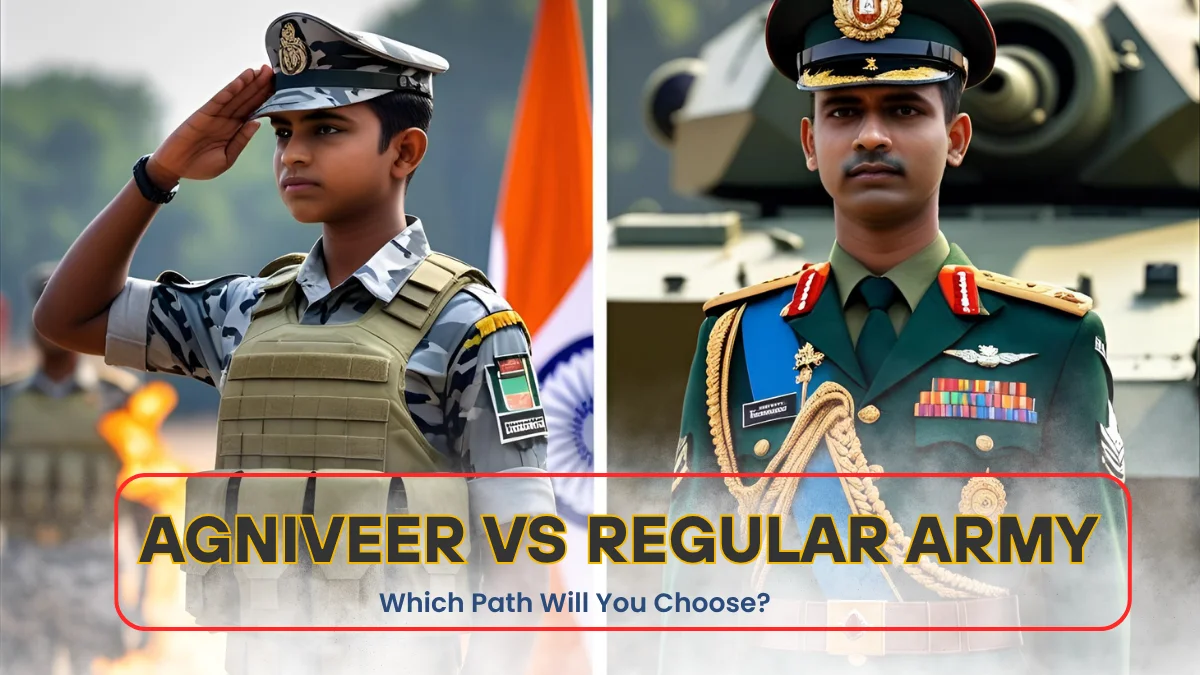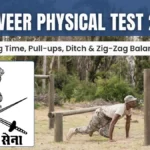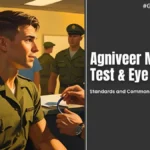Last Updated: July 26, 2025 at 12:12 pm
The Indian Armed Forces underwent a revolutionary transformation with the introduction of the Agnipath scheme in June 2022. This groundbreaking recruitment model has created two distinct categories of soldiers in the Agniveer vs Regular Army comparison that every defence aspirant must understand. If you’re aspiring to serve the nation through military service, this comprehensive analysis of Agniveer vs Regular Army differences is crucial for making an informed career decision.
What is the Agnipath Scheme?
The Agnipath recruitment scheme represents a paradigm shift in how India recruits its defence personnel. Unlike the traditional permanent recruitment system, this initiative introduces a four-year contractual service model designed to create a younger, more technologically adept military force.
Under this scheme, recruits aged 17.5 to 21 years (extended to 23 years for the initial batches) serve as Agniveers for four years. After completion, only 25% receive opportunities for permanent enrolment, whilst the remaining 75% transition to civilian careers with enhanced skills and financial benefits.
Read in Detail: What is Agniveer Scheme? Full Details About Agnipath Yojana for Defence Aspirants
Key Differences Between Agniveer and Regular Army Soldiers
Understanding the Agniveer vs Regular Army distinctions is essential for making the right career choice. Here’s a detailed comparison of both paths:
Service Duration and Career Path
Agniveer Service Model:
- Fixed four-year tenure without pension liability
- Performance-based selection for permanent cadre (25% retention rate)
- Accelerated promotion opportunities during the initial period
- Mandatory retirement after four years unless selected for regular service
Regular Army Personnel:
- Permanent service until retirement age (typically 35-60 years depending on rank)
- Structured career progression with predictable promotion timelines
- Long-term career stability with pension benefits
- Opportunity to serve in various capacities throughout their career
Financial Benefits and Compensation
Agniveer Salary Structure:
- Starting monthly package: ₹30,000 (Year 1)
- Progressive increase: ₹33,000 (Year 2), ₹36,500 (Year 3), ₹40,000 (Year 4)
- Seva Nidhi Fund contribution: 30% employee + 30% government contribution
- Risk and hardship allowances as applicable
- No traditional pension benefits
Regular Soldier Compensation:
- Pay scale varies by rank and service years
- Comprehensive allowances including dearness allowance, house rent allowance
- Gratuity and pension benefits after retirement
- Medical facilities for family members
- Canteen facilities and other welfare schemes
Read Also: Indian Army Agniveer Salary 2025: Complete Guide to Pay, Seva Nidhi & Exit Benefits
Training and Skill Development
Both categories receive rigorous military training, but the focus differs significantly:
Agniveer Training Programme:
- Intensive six-month basic military training
- Specialised technical skill development
- Modern warfare techniques and cyber security training
- Leadership development programmes
- Industry-relevant certification courses
Regular Army Training:
- Extended basic training followed by specialisation
- Continuous professional development throughout career
- Advanced command and staff courses
- International training opportunities
- Long-term leadership preparation
Read Also: Agniveer Physical Test 2025: Running Time, Pull-ups, Ditch & Zig-Zag Balance Tips
Advantages of Choosing Agniveer Path
Career Flexibility and Modern Skills
Agniveers acquire cutting-edge military technology skills that are highly valuable in civilian industries. The four-year service period provides sufficient time to master modern defence equipment, cybersecurity protocols, and advanced communication systems.
Financial Independence at Young Age
The Seva Nidhi package ensures financial security post-service. With approximately ₹11-12 lakh corpus upon completion, young veterans can pursue higher education, start businesses, or invest in skill development programmes.
Priority in Government Jobs
Agniveer veterans receive preference in Central Armed Police Forces recruitment, railway jobs, and various state government positions. This creates multiple career pathways beyond military service.
Educational Opportunities
The scheme includes provisions for continuing education during service and post-retirement scholarships for skill development courses, making it attractive for academically inclined candidates.
Potential Risks and Challenges
Job Security Concerns
The contractual nature raises questions about long-term career stability. With only 25% retention rate, 75% of Agniveers must transition to civilian careers, creating uncertainty about future employment prospects.
Limited Pension Benefits
Unlike regular soldiers, Agniveers don’t receive traditional pension benefits, which could impact long-term financial planning, especially for those not selected for permanent service.
Intense Selection Pressure
The competitive environment for permanent absorption (only 1 in 4 selected) may create stress and affect camaraderie among serving personnel.
Family and Social Considerations
The uncertainty of permanent employment may affect marriage prospects and family planning decisions for young recruits.
Future Prospects and Career Transitions
For Selected Agniveers (25%)
Those selected for regular service enjoy:
- Permanent employment with full benefits
- Career progression opportunities similar to traditional recruits
- Enhanced experience from diverse peer interactions
- Leadership roles based on proven performance
For Non-selected Agniveers (75%)
Multiple pathways exist for civilian transition:
- Reserved quotas in paramilitary forces and police services
- Priority in public sector undertaking recruitments
- Entrepreneurship support through various government schemes
- Higher education opportunities with reservation benefits
- Private sector preference due to discipline and technical skills
Read Also: What Happens After Selection in Agniveer? Full Training & Posting Process
Impact on Indian Defence Preparedness
The Agnipath scheme addresses several strategic objectives:
Modernisation Benefits
- Younger average age of armed forces personnel
- Better adaptation to modern technology and digital warfare
- Reduced pension liability allowing increased defence equipment procurement
- Enhanced physical fitness standards across services
Operational Advantages
- Faster decision-making capabilities with tech-savvy personnel
- Improved innovation in military operations
- Better civil-military integration through veteran network
- Enhanced national security through skilled civilian population
Making the Right Choice: Factors to Consider
When evaluating the Agniveer vs Regular Army decision, several critical factors should guide your choice:
Personal Circumstances
Consider your family’s financial situation, educational background, and long-term career aspirations. Those seeking immediate employment with skill development may find Agniveer attractive, whilst candidates preferring job security might favour traditional recruitment routes where available.
Risk Tolerance
Evaluate your comfort level with uncertainty. High achievers confident in their abilities may thrive in the competitive Agniveer environment, whilst risk-averse individuals might prefer permanent positions.
Career Goals
Align your choice with long-term objectives. If you’re entrepreneurially inclined or planning higher education, the Agniveer path provides flexibility. For those seeking lifelong military careers, traditional recruitment (when available) offers better prospects.
Frequently Asked Questions (FAQs)
Official Resources and Important Links
For accurate and updated information, refer to these official sources:
- Indian Army Official Website: joinindianarmy.nic.in – Latest recruitment notifications and scheme updates
- Ministry of Defence: mod.gov.in – Official Agnipath scheme documentation and policy updates
- Directorate General of Resettlement: dgr.gov.in – Ex-servicemen welfare and career guidance
- National Career Service Portal: ncs.gov.in – Government job opportunities for veterans
Internal Resources for Defence Aspirants:
- Indian Army Recruitment 2025 – Complete Notification Guide
- Physical Fitness Standards for Defence Services
- Agniveer Physical Fitness Preparation Guide: Complete Training Manual for Success
- Documents Required for Agniveer Application 2025: A Complete Checklist
- Indian Army Agniveer Selection Process 2025: Step-by-Step Guide
Conclusion
The Agniveer vs Regular Army distinction represents more than just employment models—it reflects India’s evolving defence strategy and socio-economic priorities. Both paths offer unique advantages and serve different individual aspirations and national requirements.
For aspirants, the key lies in honest self-assessment and understanding that both routes contribute meaningfully to national service. The Agnipath scheme, despite initial controversies, is creating opportunities for young Indians to serve their country whilst developing valuable skills for civilian careers.
Whether you choose the Agniveer path or pursue traditional military service, remember that serving in the Indian Armed Forces remains one of the most honourable career choices available. Your dedication, performance, and adaptability will ultimately determine your success, regardless of the recruitment model.
The future belongs to those who embrace change whilst maintaining the core values of military service: honour, courage, and commitment to the nation. Make your choice wisely, prepare thoroughly, and serve with pride.
Ready to Start Your Defence Career Journey?
Explore our comprehensive Defence Exam Preparation Resources and Military Career Counselling Services to boost your chances of success.
Stay updated with the latest Agniveer recruitment notifications and defence career opportunities at GovtCareerHub.com. Subscribe to our newsletter for expert guidance on defence exam preparation and career counselling.






